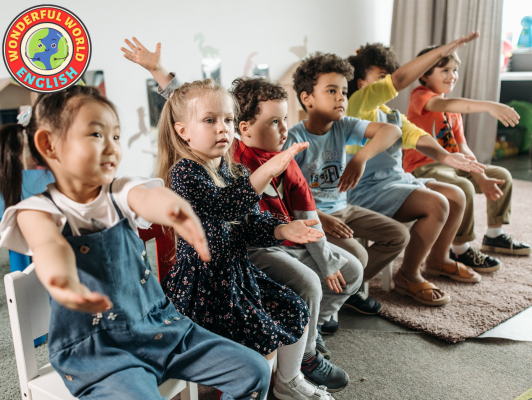Contents
Toggle
Meet David De’ Ath, founder, editor, and writer at Wonderful World English. With his extensive background as an English teacher, David provides valuable insights and practical tips on ESL for students and teachers alike.
Teaching verbs to ESL students is a fundamental aspect of helping them gain proficiency in English.
Verbs are the action words that animate language and give sentences their dynamism.
Understanding how ESL students learn and process new verbs is essential in crafting effective lesson plans.
Instructors are often challenged to make verb tenses relatable and to contextualize their usage.
Verb teaching strategies range from the innovative use of games and activities to direct instruction on form and function.
By incorporating a variety of teaching methods, instructors can cater to different learning styles and make the acquisition of new verb forms more engaging.
The goal is to create an environment where iterative practice is encouraged and where students feel comfortable experimenting with new structures.
Regular assessment and constructive feedback contribute to a learning cycle that promotes sustained incremental progress.
Key Takeaways
- Verbs are pivotal in language learning, requiring innovative and varied teaching strategies.
- A mix of instructional methods caters to diverse learning styles and keeps students engaged.
- Regular practice, assessment, and feedback are essential for students to internalize verb usage.
Understanding Verbs in ESL
When teaching English as a Second Language (ESL), it is fundamental to ensure students have a solid grasp of verbs, which are the action words in a sentence.
Verbs are pivotal for sentence construction and convey various actions, states, and occurrences.
Verb Forms and Their Uses
Base Form: The base form of a verb is its simplest form, without any tense, aspect, or mood markers.
For instance, “eat,” “run,” and “be” are base forms.
They are used as the infinitive with “to” for purposes like expressing desires or giving advice.
- Past Form: The past form indicates an action that was completed in the past. It’s commonly formed by adding “-ed” to the base form for regular verbs, such as “walk” becoming “walked.” However, for irregular verbs, the past forms could change significantly, as in “eat” becoming “ate.”
- Present Form: In its present form, a verb can express a habitual action (“She walks to school”) or a current state (“They are happy”). For most verbs, the present form is identical to the base form, except in the third person singular, which typically adds “-s” or “-es.”
- Future Form: Although English does not have a specific future form for verbs, it uses the modal “will” followed by the base form to indicate actions that will occur, such as “will eat” or “will run.”
The different forms of verbs allow students to express a multitude of actions and states across different timeframes.
The Importance of Tense
Understanding tenses is crucial in ESL as they indicate when an action takes place: past, present, or future.
- Past Tense: The past tense portrays actions completed in the past. For example, “She walked to the park.”
- Present Tense: This tense is used for actions in the current moment or habitual actions. For example, “He studies every day.”
- Future Tense: Used to describe actions that will happen, the future tense often employs “will” or “going to.” For example, “They will travel to Spain next year.”
Mastering different verb forms and tenses helps ESL students accurately describe actions and situations, which is essential for effective communication in English.

Teaching Strategies for Verbs
Effective verb instruction is a cornerstone of language acquisition.
This section details three key strategies for educators to help ESL students grasp verb usage, allowing them to communicate more accurately and fluently.
Incorporating Grammar in Lessons
When teaching verbs, it’s essential to directly integrate grammar instruction into lesson plans.
One approach includes the introduction of verbs in the context of familiar routines, followed by explicit instruction on verb tenses.
Educators might pinpoint verbs within a text and employ sentence diagramming to demonstrate how verbs function within various structures.
Using Visual Aids and Timelines
Visual aids, such as flashcards depicting actions, can be highly effective in teaching verbs.
They serve to associate words with images, simplifying the process of verb memorization.
Meanwhile, timelines provide a spatial representation of verb tenses, which can help ESL learners understand the sequencing of events and the corresponding verb forms needed to describe those time frames.
Creating Engaging Activities and Games
Activities and games elevate the learning experience from mundane to fun and interactive.
For example, a game like “Verb Charades” encourages students to convey the meaning of verbs through gestures.
Incorporating activities that involve student movement can also reinforce their understanding, making the acquisition of verbs an immersive process.
Related: Fun Classroom Games: Engage and Educate with These Ideas

Effective Practice Techniques
To foster a dynamic learning environment, teachers can incorporate interactive techniques such as role-playing and kinesthetic activities.
These methods not only engage students but also encourage the practical application of verbs in context.
Role-Playing and Simulation
In role-playing activities, students are given scenarios where they have to act out various roles by employing correct verb usage.
For example, in a restaurant simulation, they might practice verbs like “order,” “eat,” “cook,” and “serve.”
This approach helps them understand the verbs’ applications in real-life situations.
A team competition can elevate engagement where students guess verbs based on a teammate’s pantomime.
This allows them to connect physical actions with verbal expressions which enhances retention.
Running Dictation and Relay Races
Running dictation offers an energetic twist to traditional dictation.
Here, texts containing target verbs are placed around the room.
Students run to the texts, memorize them, and dictate them to a partner for transcription.
This incorporates movement, which can aid memory, and emphasizes the practical use of verbs in written communication.
Relay races can also be adapted for verb practice.
Teachers present sentences with missing verbs that teams must correctly insert.
This may involve students racing to a board to write the correct verb form, reinforcing their understanding under time pressure.

Assessment and Feedback
Instructing ESL students on verbs requires ongoing assessment and structured feedback.
These robust mechanisms aid in pinpointing how well students are absorbing the lessons and where their understanding might falter.
Monitoring Progress with Routine Exercises
Routine Verb Exercises are pivotal in gauging a student’s grasp of verb usage within the English language.
Teachers can employ a variety of verb-centered activities which serve as practical assessment tools.
For instance, regular use of fill-in-the-blank sentences can help monitor students’ progress in conjugating verbs accurately.
It’s beneficial to record results systematically, perhaps in a table format, to track improvements or recurring errors over time.
| Exercise Date | Verb Focus | Correct Answers | Incorrect Answers | Notes on Mistakes |
|---|---|---|---|---|
| MM/DD/YYYY | Past Tense | 18 | 2 | Confusion with irregular verbs |
| MM/DD/YYYY | Present Continuous | 20 | 0 | N/A |
Providing Constructive Feedback
Constructive feedback is a critical element that enhances students’ learning experience.
It not only corrects mistakes but also reinforces what has been done well.
An effective strategy, as referenced in Effective Strategies, is the “Sandwich” Technique: wherein a suggestion for improvement is nestled between two positive remarks.
By saying, “Your use of the present tense has improved greatly, though there’s a need to work on past tense irregular verbs.
However, your ability to form complex sentences is commendable,” a teacher can maintain a student’s motivation while still addressing areas that require attention.
It’s essential to maintain clear and precise language to avoid misunderstandings, ensuring feedback is actionable.

Resources for Teaching Verbs
When teaching verbs to ESL students, one needs a blend of engaging materials and dynamic tools.
Detailed below, educators will find robust resources specifically tailored for verb instruction, from printable worksheets to interactive digital platforms.
Worksheets and Lesson Plan Databases
Worksheets are a staple in verb education, offering structured practice for students.
Sites like ESL Verb Games & Activities provide a collection tailored to teaching verbs, with exercises crafted for various proficiency levels and learning styles.
Teachers can access a diverse array of worksheets designed to reinforce verb forms and uses.
Lesson Plan Databases present a treasure trove of well-organized plans.
These repositories are frequently updated with creative and comprehensive verb-focused lessons.
Emerging as a lesser-known resource, Teaching Expertise features plans that encourage active participation and include clear objectives for mastering verb tenses.
Online Tools and Applications
In the realm of Online Tools, there are applications which make learning verbs captivating.
Some of these tools allow students to engage with verbs through interactive exercises and games, providing immediate feedback and a sense of accomplishment.
For example, applications such as FluentU make use of real-life videos, turning them into personalized language learning lessons.
ESL Verb Games harness the power of gamification to teach verbs in a fun and memorable way.
They are perfect for reinforcing knowledge in a lively, less conventional format.
Many online platforms include games where students can practice verb conjugation and usage in context, adding an element of competition which can be highly motivating.

Conclusion
Teaching verbs to ESL students is essential for mastering the dynamics of English.
Instructors employ various innovative strategies, such as games, direct instruction, and contextual activities, to make learning verb tenses engaging and relatable.
The primary goal is to create a supportive learning environment where students are encouraged to practice regularly and experiment with new verb forms.
Through continual assessment and constructive feedback, educators foster a cycle of sustained progress, helping students internalize verb usage effectively.
This approach not only enhances students’ language skills but also boosts their confidence in using English in practical, real-world contexts.
We hope you find value in this information; you can contact us if you require any support.
Have a wonderful day!
Image Attribution: All images licensed via canva.com





